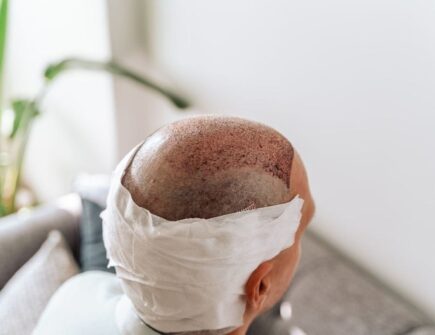Introduction
The First Seven Days After Hair Transplant is a critical period that can significantly influence the success of your procedure. During this time, the newly transplanted hair follicles are delicate and require careful handling to ensure they take root and begin the healing process. This guide will walk you through what to expect during the first seven days after a hair transplant and provide detailed care instructions to help you achieve the best possible results.
Importance of the First Week in Recovery
The first week after your hair transplant sets the foundation for a successful recovery. Proper care during this period can prevent complications, minimize discomfort, and support healthy hair growth. Understanding what to expect and how to care for your scalp will help you confidently navigate this crucial phase.
Day 1: Immediate Post-Operative Care
What to Expect After Surgery
Immediately after your hair transplant, it’s normal to experience redness, swelling, and sensitivity in the treated areas. The transplanted hair follicles will appear as tiny dots on your scalp, and you may notice some tightness or mild discomfort. These symptoms are temporary and typically subside within a few days.
Caring for the Transplant Area
The first 24 hours after your procedure are crucial for protecting the newly implanted follicles. Follow these guidelines to ensure optimal care:
- Keep Your Head Elevated: To reduce swelling, elevate your head while resting or sleeping. An extra pillow or a recliner can help maintain the proper position.
- Avoid Touching the Transplant Area: Resist the urge to touch, rub, or scratch the scalp, which can dislodge the grafts and interfere with the healing process.
- Follow Your Surgeon’s Instructions: Adhere strictly to your surgeon’s aftercare instructions, including any recommendations for washing or applying topical treatments.
Day 2-3: Managing Early Recovery
Washing and Cleaning the Scalp
Around day two or three, your surgeon may advise you to start gently washing your scalp. Here’s how to do it safely:
- Use Lukewarm Water: Wash your scalp with lukewarm water to avoid irritating the area.
- Gently Apply Shampoo: Use a mild, surgeon-approved shampoo. Apply it lightly with your fingertips, avoiding any rubbing or scrubbing motions.
- Rinse Carefully: Gently rinse the scalp, ensuring the water flow is soft and does not directly hit the transplanted area.
Pain Management
Some discomfort is standard in the first few days after your transplant. To manage this:
- Take Prescribed Medications: Your surgeon may prescribe pain relievers or anti-inflammatory medications to help manage discomfort. Take these as directed.
- Apply Cold Compresses: To reduce swelling, apply a cold compress to the forehead or back of the head (but not directly on the transplant area).
Day 4-5: Monitoring Healing Progress
What’s Normal and What’s Not
As you progress through the first week, monitoring your healing is essential. Here’s what to look out for:
- Typical Signs: Some redness, mild swelling, and itching are expected as the scalp begins to heal.
- Signs of Complications: Watch for increased redness, severe pain, pus, or unusual swelling. If you notice any of these symptoms, contact your surgeon immediately.
Activity Restrictions
During the first week, it’s essential to protect the grafts by limiting certain activities:
- Avoid Strenuous Activities: Refrain from heavy lifting, bending over, or engaging in strenuous exercise, as these can increase blood pressure on the scalp and disrupt the grafts.
- Protect the Scalp: If you must go outside, wear a loose-fitting hat to shield the scalp from direct sunlight and environmental pollutants.
Day 6-7: Preparing for the Next Phase
Expecting Scab Formation
By the end of the first week, you may notice scabs forming over the transplanted areas. This is a normal part of the healing process.
- Caring for Scabs: Do not pick or scratch the scabs. They will naturally fall off as the healing progresses. When washing your scalp, be gentle to avoid disturbing them.
- Gentle Handling of the Scalp: Continue to treat your scalp with care. Avoid using any hair products that your surgeon does not recommend.
Transitioning to Long-Term Care
As you approach the end of the first week, you’ll begin transitioning to longer-term aftercare:
- What’s Next in the Recovery Process: After the first week, you’ll start to see the shedding phase, where the transplanted hairs fall out to make way for new growth. This is a normal part of the process.
- Setting Expectations for the Coming Weeks: It’s essential to remain patient. The full results of your hair transplant will take several months to develop.
Common Concerns During the First Week
Itching and Sensitivity
Itching is a common experience as the scalp heals, but it’s essential to manage it carefully:
- Safe Ways to Relieve Itching: Over-the-counter antihistamines or a surgeon-approved topical treatment can help if itching becomes uncomfortable. Avoid scratching at all costs.
Shock Loss Anxiety
The shedding of transplanted and surrounding hairs, known as shock loss, is a typical phase that can cause anxiety:
- Understanding Early Shedding: In the first seven days after a hair transplant, hair loss, known as shock loss, typically occurs within the first two to three weeks post-transplant and is a normal part of the hair restoration process. The hair will regrow in the following months.
Dealing with Swelling
Swelling, particularly around the forehead and eyes, can occur after a hair transplant:
- Tips for Reducing Swelling: Keep your head elevated while sleeping, and apply cold compresses to the forehead if necessary. The swelling usually subsides within a few days.
Conclusion
The first week after your hair transplant is critical for ensuring your procedure’s success. Following these aftercare instructions and monitoring your healing progress can help protect the newly transplanted hair follicles and set the stage for healthy hair growth. Remember, each person’s recovery process is unique, so stay in close contact with your surgeon, and don’t hesitate to reach out with any questions or concerns. With proper care, you can look forward to seeing your hair transplant’s full results in the coming months.
Frequently Asked Questions (FAQs)
How should I sleep after a hair transplant?
Sleep with your head elevated for the first few days to reduce swelling and protect the grafts.
When can I wash my hair for the first time?
Your surgeon recommends gently washing your hair around day two or three using a mild shampoo and lukewarm water.
Is it normal for scabs to form?
Yes, scabs are a normal part of the healing process. Avoid picking or scratching them; they will fall off naturally.
What should I do if I accidentally touch or bump the grafts?
If you accidentally touch or bump the grafts, try not to worry. Contact your surgeon for advice if you’re concerned about any impact on the grafts.
When should I contact my surgeon during the First Seven Days After Hair Transplant?
Contact your surgeon if you notice signs of infection, such as increased redness, pus, or severe pain, or if you have any concerns about your healing process.







